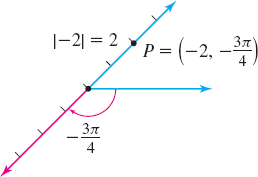EXAMPLE 2Plotting a Point Using Polar Coordinates
Plot the point P whose polar coordinates are (−2,−3π4). Then find three other polar coordinates of the same point with the properties:
(a) r>0 and 0<θ<2π
(b) r>0 and −2π<θ<0
(c) r<0 and 0<θ<2π
Solution The point (−2,−3π4) is located by first drawing the angle −3π4. Then P is on the extension of the terminal side of θ through the pole at a distance 2 units from the pole, as shown in Figure 31.
(a) The point P=(r,θ), r>0, 0<θ<2π is (2,π4), as shown in Figure 32(a).
(b) The point P=(r,θ), r>0, −2π<θ<0 is (2,−7π4), as shown in Figure 32(b).
(c) The point P=(r,θ), r<0, 0<θ<2π is (−2,5π4), as shown in Figure 32(c).
